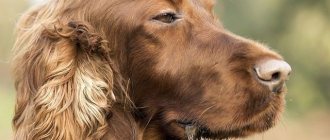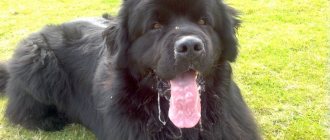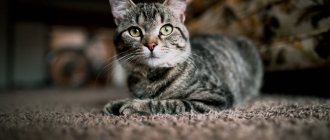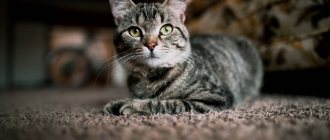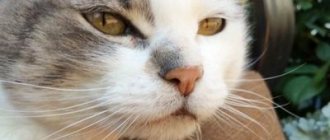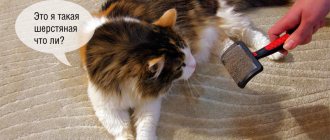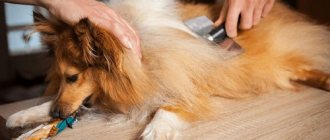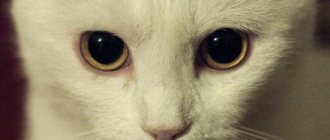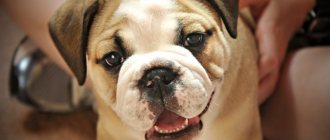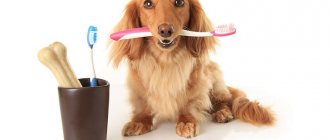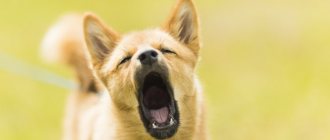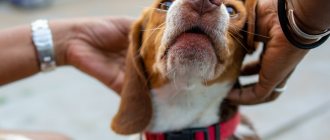Increased salivation in dogs worries the owners. When there are no signs of disease, you are annoyed by damage to upholstered furniture. Saliva causes allergies in children. If you do not wash your hands, there is a risk of infection with worms and other contagious diseases common to dogs and humans.
In the article, I described 12 causes of increased salivation and recommendations for them. You will learn when severe drooling is normal, and in what cases your pet needs to be treated.
List of the most slobbery breeds.
What does normal salivation look like?
Saliva is a clear liquid secreted by the sublingual, parotid and submandibular glands. May be viscous or liquid. Functions of salivary fluid:
- easier swallowing;
- breakdown of carbohydrates, the beginning of the process of food digestion;
- bactericidal - protecting the animal from infections and diseases acquired through nutrition (by eating, ingesting).
Salivation (salivation) occurs reflexively, depending on the structure of the stimulus - there is a much larger amount of saliva for dry food. Normal salivation does not involve unsightly drooping or dripping of saliva from the animal's lips, unless the pet belongs to a breed for which this is typical.
Photo: flickr.com
The role of saliva
Saliva is a vital serous-mucosal secretion secreted by 3 pairs of large and several small glands located in the dog’s mouth. Its functions:
- moisturizes the oral mucosa;
- promotes the recognition of the taste of food and the production of gastric juice;
- facilitates the passage of food into the stomach;
- improves food digestion;
- neutralizes and removes toxins.
Antimicrobial substances in saliva help disinfect wounds, which is why they say: “heals like a dog.”
Causes of hypersalivation
Hypersalivation is not always a cause for concern; in some cases it is a variant of the norm.
Physiological reasons
Dog physiology allows for copious amounts of saliva.
- the pet belongs to a breed with a specific jaw structure;
- high ambient temperature;
- response to upcoming feeding. The dog reflexively reacts to the sound of dishes, the smell of food, and human actions in preparing a portion of food;
- reaction to taking medications - saliva is produced in an enhanced mode to dilute toxic, tasteless or rejected substances;
- reaction to the beginning of teeth change in puppies (3-4 months). Saliva is like water, without mucus.
Psychological reasons
One of the symptoms that your four-legged friend is experiencing stress is drooling profusely from the mouth. Stress is possible:
- traveling in a car - the dog becomes lethargic, breathing quickens, drooling, and vomiting is possible;
- participation in the exhibition process;
- meeting and communicating with other animals, especially in the absence of proper socialization;
- meeting the owner - joyful excitement;
- moving to a new house is stressful at first;
- communication with a stranger.
To relieve the effects of stressful situations, you can contact your veterinarian to prescribe a sedative and anti-sickness medications.
Pathogenic causes
Increased salivation in a dog will require special attention from the owner if it is accompanied by additional symptoms indicating the presence of the disease. The range of such diseases is very wide:
- diseases of the oral cavity. If there are problems with the mouth, the dog tries to choose softer food, ignoring dry and hard foods. Ulcers, inflamed mucous membranes, wounds cause pain;
- foreign body in the mouth - fish bone, wooden splinter and others. Saliva may be mixed with blood. If possible, remove such an object and contact a veterinary clinic;
- caries. The dog tries to eat food with one side of its mouth that does not cause pain. Unpleasant odor and drooling, food falls out of the mouth;
- malocclusion. Constant injury to the mucous membrane, tongue and gums causes pain and, as a reaction, hypersalivation;
- diseases and injuries of the ears. The parotid glands are involved in the production of salivary fluid more than other glands. In case of illness (otitis, tumor) or injury, increased salivation begins. Other symptoms: the dog shakes its sore ear, the smell of pus, lethargy, fever;
- infectious diseases - rabies, parvovirus enteritis, leptospirosis and others. Vaccination is necessary as a preventive measure. Rabies is dangerous for humans;
- helminthic infestations;
- epilepsy - a disease that causes periodic seizures, leading to complete or partial loss of consciousness in the dog. Excessive flow of saliva is a sign of an approaching attack;
- poisoning - can be caused by eating very fatty foods or getting toxic substances into the mouth. Most often accompanied by vomiting, which is preceded by salivation. The dog behaves restlessly, licks its face, has the urge to vomit, and the dog tries to devour inedible household items.
The above cases require qualified assistance. Do not waste time and contact a veterinarian for a diagnosis, follow the proposed treatment regimen.
Photo: flickr.com
Poisoning
Most often, an abundance of saliva occurs when the body is poisoned. And this is not necessarily low-quality food; it is enough to “overload” the stomach with your pet’s favorite dish or give it chocolate, specific fruits, or even fatty pork that is harmful to dogs.
Saliva may appear as a reaction to contact with household chemicals or poisons used in the household. Once in the body, they cause nausea, accompanied by vomiting and severe salivation.
In such a situation, it is necessary to rinse the stomach; this can be done with a large enema with water, forcing the pet to drink a lot of liquid, causing a gag reflex. After the water coming out becomes clean, you can feed the coal, energy gel (putting it on the root of the tongue), and give the animal a rest.
In case of relapse or poisoning, immediately take it to a veterinary clinic.
Veterinarians' comments
Ivan Z.
The owners of an 8-month-old St. Bernard contacted me. This is a “slobbery” breed. But in this case, the dog did not eat, had difficulty lapping up water and moaned in pain. Diagnosis: jaw dislocation. This is the first time in my practice. The dog's drool flowed like a river and had a thick consistency.
Elena O.
An interesting case in my practice. The owners of a 4-year-old shorthaired pointer noticed severe hypersalivation in the dog, which occurs after trips to nature in the warm season. The flow stopped after a day or a little more. There were suspicions about the development of the disease. We went to the clinic.
Initially, it was thought that the dog suffered from heatstroke every walk. Further it turned out that the dog ate and licked lizards and frogs, the increased flow of saliva was the body’s reaction, and was not accompanied by additional symptoms.
Chronic illnesses
Like humans, our furry friends also suffer from chronic diseases, some of which cause increased thirst, causing the dog to increase water intake and, as a result, produce more saliva. Excessive salivation signals an exacerbation of a chronic disease:
- gastrointestinal tract (ulcers, gastritis may occur),
- liver
- gallbladder.
Sometimes a similar symptom occurs in bitches suffering from false pregnancy.
Which breeds are most susceptible
When choosing a four-legged friend, you should remember the existence of so-called “slobbery” breeds. You should not focus only on the external qualities of the animal. A dog that constantly drools and leaves it on pieces of furniture, in the car and on the owner’s clothes is unlikely to please anyone who was not aware of these features.
These breeds have a wide mouth, incomplete closure of the jaws, hanging jowls. It is difficult for liquids and food to stay in such jaws. “Slobbery” breeds include:
- bulldog;
- Dogue de Bordeaux;
- mastiff;
- amstaff, pit bull;
- Saint Bernard;
- mastino neapoletan;
- Shar Pei;
- bullmastiff;
- Newfoundland and others.
Photo: flickr.com
Stressful situations
Excessive saliva manifests itself as a reaction associated with the animal’s psyche, most often due to stress experienced. In this case, the animal may develop a tic, its jaw will twitch nervously, churning saliva into a copious foam.
This may be caused by:
- departure of the owners who left the pet with strangers,
- change of place of residence,
- a fight provoked by another animal,
- excessive zeal in training,
- the appearance of a “competitor” in the person of a newborn,
- constant punishment from the owners.
In this case, it is necessary to resolve the issue by obtaining recommendations from a veterinarian; most likely, they will prescribe sedatives. You can offer your pet a treat or take it with you for a long walk. Just give him maximum attention, show that everyone still loves him. After returning home, you need to pay attention to the dog for several days.
Travel can sometimes be stressful, but most dogs still love to travel with their owners. But if, nevertheless, the animal is frightened, it is necessary to give sedatives, stroke it, and, if possible, take the pet in your arms. When motion sickness occurs, you need to train the dog, gradually accustoming it to transport or pre-administering special medications.
Traveling with a slobbering dog is not the most pleasant situation; here you need to stock up on bibs, absorbent diapers and napkins. If the cabin is hot, then there will definitely be saliva; here, if possible, you need to turn on the air conditioning or provide access to cool air. As an option, stop more often to allow your pet to catch its breath.
Occasionally, the cause of stress, the consequence of which is drooling, is caused by the close presence of a female dog in heat; this is a normal reaction for a mature male.
Briefly about the main thing
- The formation of saliva is a natural physiological process necessary for normal digestion;
- Normally, salivation does not cause saliva to hang or flow from the dog's mouth;
- For some breeds, increased salivation is the norm;
- Factors of salivary fluid flow: physiological, psychological, pathogenic;
- Physiological ones do not cause prolonged drooling in the dog;
- Pathogenic - the most serious and caused by the presence of a disease that requires treatment by a veterinarian;
- At home, it is possible to alleviate the dog’s condition and monitor its further well-being.
Infections caused by viruses
Every pet can get sick; fever, dry nose, refusal to eat, increased thirst, apathy are reasons to consult a specialist. And an increased amount of drool may indicate a viral disease contracted by the dog.
The list of viral diseases carried by animals includes:
- carnivore plague,
- hepatitis,
- enteritis,
- tracheobronchitis,
- parainfluenza
All these diseases can be treated exclusively in a veterinary hospital.
German dog
The Great Dane is one of the most popular of the giant breeds, as well as one of the largest. Despite their size, their below-average lifespan, and the fact that they are known for their generous slobbering, they can make excellent, easy-going family companions if you have room for them.
They are known to be people pleasers and form strong bonds with their family, including children, with whom they are usually very affectionate.
Drooling while traveling
Not all four-legged pets easily tolerate riding in a car or other transport, even over short distances. Often this process is accompanied by stress and psycho-emotional complications.
The causes of increased salivation in dogs mentioned above are related to each other. Some tailed friends get motion sickness while traveling by car due to imperfections in the vestibular system.
The clinical picture of this condition is represented by depression, rapid breathing, excessive salivation in combination with foam, nausea and vomiting. In most cases, this goes away as the animal matures. As a rule, adult individuals no longer experience such ailment. For prevention, you can take special medications. Only a veterinarian can prescribe medications after examining the pet’s health condition.
Diagnostics in a veterinary clinic
When contacting a specialist, the owner must tell in detail about the dog’s lifestyle, peculiarities of keeping and feeding, contacts with other animals, medications used recently, and other symptoms. The veterinarian’s task is to differentiate normal drooling from salivation, accompanied by gagging and smacking.
To diagnose the disease, the veterinarian will conduct a complete neurological and physical examination of the animal (special attention to the oral cavity and neck area) and diagnostic tests, including a complete blood count (general, biochemical), urine tests, stool tests, ultrasound, x-rays, biopsy ( if a disorder of the immune system is suspected), washings from the mucous membranes.
Saint Bernard
These large and sensitive giants come from the Swiss Alps. They are sweet, protective and loyal companions, and despite their size, can be great with children.
The breed does well in cold climates, but does not do well in very hot regions. You may find that they drool even more in hot weather in an attempt to stay cool. If you've seen the movie Beethoven starring a St. Bernard, you've probably noticed how slobbery these dogs can be.
